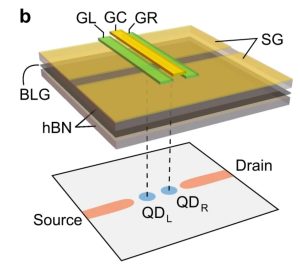The 2D Materials and Quantum Devices Group published new results on low-energy single-electron spectra in bilayer graphene quantum dots.
Publication: Banszerus, L., Möller, S., Steiner, C. et al. Spin-valley coupling in single-electron bilayer graphene quantum dots. Nat Commun12, 5250 (2021). https://doi.org/10.1038/s41467-021-25498-3

Schematic cross-section of the device. The upper part shows the metallic gates on top of the hBN/BLG/hBN van-der-Waals heterostructure. The lower part color codes the charge carrier density within the channel and the two quantum dots (red: holes and blue: electrons).
Abstract: Understanding how the electron spin is coupled to orbital degrees of freedom, such as a valley degree of freedom in solid-state systems, is central to applications in spin-based electronics and quantum computation. Recent developments in the preparation of electrostatically-confined quantum dots in gapped bilayer graphene (BLG) enable to study the low-energy single-electron spectra in BLG quantum dots, which is crucial for potential spin and spin-valley qubit operations. Here, we present the observation of the spin-valley coupling in bilayer graphene quantum dots in the single-electron regime. By making use of highly-tunable double quantum dot devices we achieve an energy resolution allowing us to resolve the lifting of the fourfold spin and valley degeneracy by a Kane-Mele type spin-orbit coupling of ≈ 60 μeV. Furthermore, we find an upper limit of a potentially disorder-induced mixing of the K and K′ states below 20 μeV.